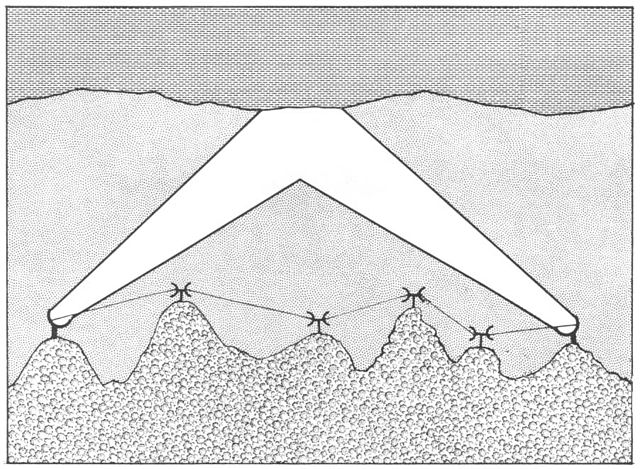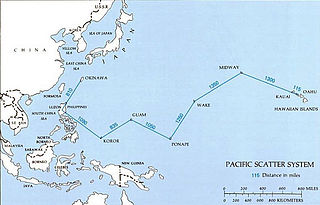Loading AI tools
Method of communicating with microwave radio signals over considerable distances From Wikipedia, the free encyclopedia
Tropospheric scatter, also known as troposcatter, is a method of communicating with microwave radio signals over considerable distances – often up to 500 kilometres (310 mi) and further depending on frequency of operation, equipment type, terrain, and climate factors. This method of propagation uses the tropospheric scatter phenomenon, where radio waves at UHF and SHF frequencies are randomly scattered as they pass through the upper layers of the troposphere. Radio signals are transmitted in a narrow beam aimed just above the horizon in the direction of the receiver station. As the signals pass through the troposphere, some of the energy is scattered back toward the Earth, allowing the receiver station to pick up the signal.[1]



Normally, signals in the microwave frequency range travel in straight lines, and so are limited to line-of-sight applications, in which the receiver can be 'seen' by the transmitter. Communication distances are limited by the visual horizon to around 48–64 kilometres (30–40 mi). Troposcatter allows microwave communication beyond the horizon. It was developed in the 1950s and used for military communications until communications satellites largely replaced it in the 1970s.
Because the troposphere is turbulent and has a high proportion of moisture, the tropospheric scatter radio signals are refracted and consequently only a tiny proportion of the transmitted radio energy is collected by the receiving antennas. Frequencies of transmission around 2 GHz are best suited for tropospheric scatter systems as at this frequency the wavelength of the signal interacts well with the moist, turbulent areas of the troposphere, improving signal-to-noise ratios.
Prior to World War II, prevailing radio physics theory predicted a relationship between frequency and diffraction that suggested radio signals would follow the curvature of the Earth, but that the strength of the effect would fall off rapidly and especially at higher frequencies. In spite of this widespread belief, during the war there were numerous incidents in which high-frequency radar signals were able to detect targets at ranges far beyond the theoretical calculations. In spite of these repeated instances of anomalous range, the matter was never seriously studied.[2]
In the immediate post-war era, the limitation on television construction was lifted in the United States and millions of sets were sold. This drove an equally rapid expansion of new television stations. Based on the same calculations used during the war, the Federal Communications Commission (FCC) arranged frequency allocations for the new VHF and UHF channels to avoid interference between stations. To everyone's surprise, interference was common, even between widely separated stations. As a result, licenses for new stations were put on hold in what is known as the "television freeze" of 1948.[2]
Bell Labs was among the many organizations that began studying this effect, and concluded it was a previously unknown type of reflection off the tropopause. This was limited to higher frequencies, in the UHF and microwave bands, which is why it had not been seen prior to the war when these frequencies were beyond the ability of existing electronics. Although the vast majority of the signal went through the troposphere and on to space, the tiny amount that was reflected was useful if combined with powerful transmitters and very sensitive receivers. In 1952, Bell began experiments with Lincoln Labs, the MIT-affiliated radar research lab. Using Lincoln's powerful microwave transmitters and Bell's sensitive receivers, they built several experimental systems to test a variety of frequencies and weather effects. When Bell Canada heard of the system they felt it might be useful for a new communications network in Labrador and took one of the systems there for cold weather testing.[2]
In 1954 the results from both test series were complete and construction began on the first troposcatter system, the Pole Vault system that linked Pinetree Line radar systems along the coast of Labrador. Using troposcatter reduced the number of stations from 50 microwave relays scattered through the wilderness to only 10, all located at the radar stations. In spite of their higher unit costs, the new network cost half as much to build as a relay system. Pole Vault was quickly followed by similar systems like White Alice, relays on the Mid-Canada Line and the DEW Line, and during the 1960s, across the Atlantic Ocean and Europe as part of NATO's ACE High system.

The propagation losses are very high; only about one trillionth (10×10−12) of the transmit power is available at the receiver. This demands the use of antennas with extremely large antenna gain. The original Pole Vault system used large parabolic reflector dish antennas, but these were soon replaced by billboard antennas which were somewhat more robust, an important quality given that these systems were often found in harsh locales. Paths were established at distances over 1,000 kilometres (620 mi). They required antennas ranging from 9 to 36 metres (30 to 118 ft) and amplifiers ranging from 1 kW to 50 kW. These were analogue systems which were capable of transmitting a few voice channels.
Troposcatter systems have evolved over the years. With communication satellites used for long-distance communication links, current troposcatter systems are employed over shorter distances than previous systems, use smaller antennas and amplifiers, and have much higher bandwidth capabilities. Typical distances are between 50 and 250 kilometres (31 and 155 mi), though greater distances can be achieved depending on the climate, terrain, and data rate required. Typical antenna sizes range from 1.2 to 12 metres (3 ft 11 in to 39 ft 4 in) while typical amplifier sizes range from 10 W to 2 kW. Data rates over 20 Mbit/s can be achieved with today's technology.
Tropospheric scatter is a fairly secure method of propagation as dish alignment is critical, making it extremely difficult to intercept the signals, especially if transmitted across open water, making them highly attractive to military users. Military systems have tended to be ‘thin-line’ tropo – so called because only a narrow bandwidth ‘information’ channel was carried on the tropo system; generally up to 32 analogue (4 kHz bandwidth) channels. Modern military systems are "wideband" as they operate 4-16 Mbit/s digital data channels.
Civilian troposcatter systems, such as the British Telecom (BT) North Sea oil communications network, required higher capacity ‘information’ channels than were available using HF (high frequency – 3 MHz to 30 MHz) radio signals, before satellite technology was available. The BT systems, based at Scousburgh in the Shetland Islands, Mormond Hill in Aberdeenshire and Row Brow near Scarborough, were capable of transmitting and receiving 156 analogue (4 kHz bandwidth) channels of data and telephony to / from North Sea oil production platforms, using frequency-division multiplexing (FDMX) to combine the channels.
Because of the nature of the turbulence in the troposphere, quadruple diversity propagation paths were used to ensure 99.98% reliability of the service, equating to about 3 minutes of downtime due to propagation drop out per month. The quadruple space and polarisation diversity systems needed two separate dish antennas (spaced several metres apart) and two differently polarised feed horns – one using vertical polarisation, the other using horizontal polarisation. This ensured that at least one signal path was open at any one time. The signals from the four different paths were recombined in the receiver where a phase corrector removed the phase differences of each signal. Phase differences were caused by the different path lengths of each signal from transmitter to receiver. Once phase corrected, the four signals could be combined additively.

The tropospheric scatter phenomenon has been used to build both civilian and military communication links in a number of parts of the world, including:
| Tower ID | Location | Staffing unit | Mainland station | Notes |
|---|---|---|---|---|
| TT-1 | Cashes Ledge off New Hampshire coast 42°53′N 68°57′W |
Not built | ||
| TT-2 | Georges Bank off Cape Cod 41°45′0.00″N 67°46′0.00″W |
762d Radar Squadron | North Truro Air Force Station | decommissioned 1963 |
| TT-3 | Nantucket Shoals 40°45′00.00″N 69°19′0.00″W |
773d Radar Squadron | Montauk AFS | decommissioned 1963 |
| TT-4 | off Long Beach Island, New Jersey 39°48′N 72°40′W |
646th Radar Squadron | Highlands Air Force Station | collapsed (1961) |
| TT-5 | Browns Bank south of Nova Scotia 42°47′N 65°37′W |
Not built |



As well as the permanent networks detailed above, there have been many tactical transportable systems produced by several countries:[20]

The U.S. Army and Air Force use tactical tropospheric scatter systems developed by Raytheon for long haul communications. The systems come in two configurations, the original "heavy tropo", and a newer "light tropo" configuration exist. The systems provide four multiplexed group channels and trunk encryption, and 16 or 32 local analog phone extensions. The U.S. Marine Corps also uses the same device, albeit an older version.
Seamless Wikipedia browsing. On steroids.
Every time you click a link to Wikipedia, Wiktionary or Wikiquote in your browser's search results, it will show the modern Wikiwand interface.
Wikiwand extension is a five stars, simple, with minimum permission required to keep your browsing private, safe and transparent.